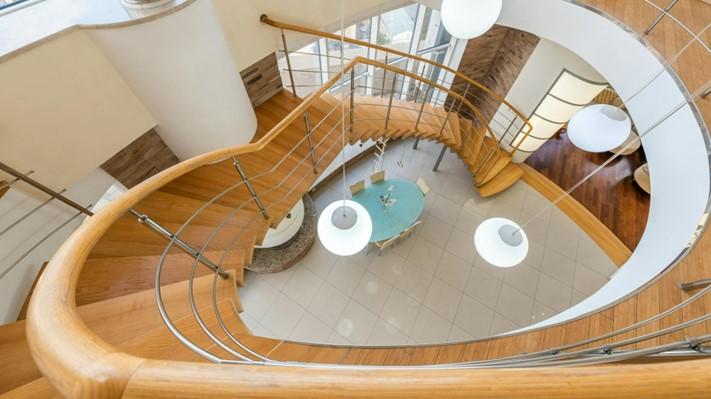Pros and Cons of Using Wood, Stone, and Concrete for Stairs
Stairs are more than just a way to navigate different levels in a building; they're a prominent design element that can enhance the aesthetics and functionality of your space. But with so many building materials available, choosing the right one for your stairs can be challenging.
We outline the advantages and disadvantages of wood, stone, and concrete building materials to help you make an informed decision:
The Classic Choice: Wood
Wood is a timeless material well-known for its warmth, natural beauty, and versatility. It offers various species, each with unique grain patterns and colour tones. From the rich mahogany to the clean lines of white oak, wood can seamlessly blend with any interior design style.
Pros:
- Warmth and Beauty: Wood creates a classic and inviting atmosphere.
- Versatility: Available in various species, colours, and finishes to match your style.
- Workability: You can shape and customise wood to create unique designs, curves, and intricate details.
- Relatively Affordable: Wood can be cost-effective, unlike stone, especially for simpler stair designs.
- Repairs: You can sand and refinish minor scratches and dents, extending the lifespan of the stairs.
Cons:
- Maintenance: Wood requires regular cleaning and occasional refinishing to maintain its beauty and prevent wear.
- Susceptibility to Moisture: Wood can warp and rot in areas with high humidity or water exposure.
- Durability: While sturdy, wood can be susceptible to scratches, dents, and wear over time compared to other materials.
- Fire Safety: Wood is not naturally fire-resistant, a crucial consideration for safety regulations.
Stone: A Touch of Luxury
Stone stairs exude elegance and sophistication, adding a luxurious touch to any space. Natural stone like granite, marble, or slate is known for its durability and timeless appeal.
Pros:
- Durability: Stone is a durable and scratch-resistant stair material perfect for high-traffic areas.
- Luxury Appeal: Natural stone elevates the aesthetics of a space, offering a sense of grandeur and sophistication.
- Fire Resistance: Stone is naturally fire-resistant, adding to the overall safety of your building.
- Low Maintenance: Stone requires minimal maintenance and occasional cleaning with the proper cleaning solutions.
Cons:
- Cost: Natural stone is one of the most expensive stair materials, with the price varying depending on the type and rarity of the stone.
- Weight: Stone is heavy, requiring a heavy-duty substructure for support. This aspect can also be a factor during installation.
- Slippery: Some stone surfaces can be extra slippery when wet. Consider adding textured finishes or non-slip treads for safety.
- Coldness: Stone feels cold to the touch, which might not be ideal for all climates.
Concrete: Strength and Versatility
Concrete is a top contender for commercial buildings and modern residential spaces. It offers unparalleled strength and can be moulded into various shapes, allowing you to explore contemporary and unique stair designs.
Pros:
• Durability: Concrete can withstand heavy loads, suitable for high-traffic areas.
• Versatility: Concrete can be pre-cast into various shapes and sizes, allowing for custom designs.
• Fire Resistance: Concrete is naturally fire-resistant, contributing to overall fire safety.
• Low Maintenance: Like stone, concrete requires minimal maintenance beyond occasional cleaning.
Cons:
• Aesthetics: Concrete can appear cold and industrial to some. Staining, polishing, or adding tile can enhance its visual appeal.
• Weight: Concrete is heavy and requires a strong substructure for support.
• Installation: Pouring concrete stairs requires skilled labour and can be lengthy. Pre-cast options offer faster installation but limit design flexibility.
• Coldness: Concrete feels cold to the touch, similar to stone.
Choosing the most suitable stair material is an important decision that impacts your space's aesthetics, functionality, and safety. By considering the various building materials available, their pros and cons, and your specific needs, you can create beautiful and functional stairs that will last for years.
